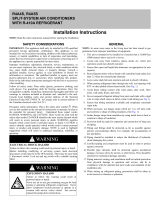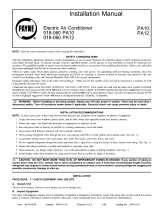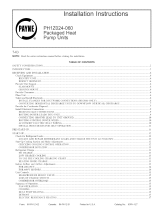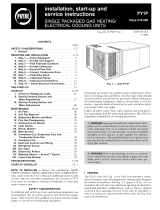Page is loading ...

HEATING & COOUNG
Visit www.carrier.cmn
38TRA
Air Conditioning Unit
Installation and Start-Up Instructions
NOTE: Read the entire instruction manual before starting the
installation.
This symbol =-> indicates a change since the last issue.
SAFETY CONSIDERATIONS
Improper installation, adjustment, alteration, service, maintenance,
or use can cause explosion, fire, electrical shock, or other
conditions which may cause personal injury or property damage.
Consult a qnalified installer, service agency, or your distributor or
branch for information or assistance. The qualified installer or
agency must use factory-authorized kits or accessories when
modifying this product. Refer to the individual instructions pack-
aged with the kits or accessories when installing.
Follow all safety codes. Wear safety glasses and work gloves. Use
quenching cloth for brazing operations. Have fire extinguisher
available. Read these instructions thoroughly and follow all
warning or cautions attached to the unit. Consult local building
codes and National Electrical Code (NEC) for special reqnire-
lilents.
Recognize safety information. This is the safety-alert symbol z_ •
When you see this symbol on the unit and in instructions or
manuals, be alert to the potential for personal injury.
Understand these signal words; DANGER, WARNING, and
CAUTION. These words are used with the safety-alert symbol.
DANGER identifies the most serious hazards which will result in
severe personal injury or death. WARNING signifies hazards
which could result in personal injury or death. CAUTION is used
to identify unsafe practices which would result in minor personal
injury or product and property damage. NOTE is used to highlight
suggestions which will result in enhanced installation, reliability,
or operation.
¥.,_ "EY!3;_II_r3
Before installing, modifying, or servicing system, main elec-
trical disconnect switch must be in the OFF position. There
may be more than 1 disconnect switch. Lock out and tag
switch with a suitable warning label. Electrical shock can
cause personal injury or death.
INSTALLATION RECOMMENDATIONS
NOTE: In some cases, noise in the living area has been traced to
gas pulsations fi'om improper installation of equipment.
i. Locate the unit away l}om windows.
2. Ensure that vapor and liquid line diameters are appropriate to
the capacity of the unit. (See Table 1.)
3. Run refrigerant robes as directly as possible by avoiding
unnecessary tunas and bends.
4. Leave some slack between the structure and the unit to absorb
vibration.
A98516
Fig. 1--Model 38TRA
5. When passing refrigerant robes through the wall, seal the
opening with RTV or other pliable silicon-based caulk. (See
Fig. 3.)
6. Avoid direct lineset contact with water pipes, ductwork, floor
joists, wall studs, floors, and walls.
7. Do not suspend rel}igerant robing fi'om joists and studs with a
rigid wire or strap which comes in direct contact with the
tubing. (See Fig. 3.)
8. Ensure that tubing insulation is pliable and completely sur-
rounds the vapor line.
9. When necessary, use hanger straps which are 1 in. wide and
conform to the shape of the tubing insulation. (See Fig. 3.)
10. Isolate the hanger straps from the insulation by using metal
sleeves bent to conlbrm to the shape of the insulation.
When outdoor unit is connected to _actory-approved indoor unit,
outdoor unit contains system refrigerant charge for operation with
factory-approved indoor unit of the same size when connected by
15 ft of field-supplied tubing. For proper unit operation, check
refrigerant charge using charging information located on control
box cover.
IMPORTANT: Maxinmm liquid-line size is 3/8-in. O.D. for all
residential applications including long line.
IMPORTANT: Always install a liquid line filter drier on any
system using an existing field service lineset and/or indoor
evaporator coil or fan coil. Also, always use liquid line filter driers
on burnout compressor replacements. Refer to Product Data Digest
for appropriate part number. Obtain filter driers fi'om your local
distributor or branch.
Manufacturer reserves the right to discontinue, or change at any time, specifications or designs without notice and without incurring obligations.
PC 101 Catalog No 533-80090 Printed in USA. Form 38TRA-6Sl Pg 1 02-03 Replaces: 38TRA-5Sl

Table 1--Refrigerant Connections and Recommended Liquid and Va
LIQUID VAPOR
UNIT SIZE
Connection Diameter Tube Diameter Connection Diameter Tube Diameter
018, 024 3/8 3/8 5/8 5/8
030, 036 3/8 3/8 3/4 3/4
042, 048 3/8 3/8 7/8 7/8
060 3/8 3/8 7/8 !-1/8
_or Tube Diameters (In.)
VAPOR (LONG LINE)
Connection Diameter Tube Diameter
5/8 3/4
3/4 7/8
7/8 1-1/8
7/8 1-1/8
Notes: 1 Tube diameters are for lengths up to 50 ft. For tube sets over 50 ft horizontal and/or 20 ft vertical differential consult Residential Long-Line Application GuideIine.
2. Do not apply capilIary tube indoor coils to these units.
INSTALLATION
Step l--Check Equipment and Job Site
UNPACK UNIT Move to final location. Remove carton taking
care not to damage unit.
INSPECT EQUIPMENT File claim with shipping company
prior to installation if shipment is damaged or incomplete. Locate
unit rating plate on unit service panel. It contains information
needed to properly install unit. Check rating plate to be sure unit
matches job specifications.
Step 2--Install on a Solid, Level Mounting Pad
If" conditions or local codes require the unit be attached to a pad,
tie down bolts should be used and fastened through knockouts
provided in unit base pan. Refer to unit mounting pattern shown in
Fig. 2 to determine base pan size and knockout hole location.
On rooftop applications, mount on level platform or frame. Place
unit above a load-bearing wall and isolate unit and tubing set fi'om
structure. Arrange supporting members to adequately support unit
and minimize transmission of vibration to building. Consult local
codes goveruing rooftop applications.
Roof mounted units exposed to winds above 5 mph may require
wind baffles. Consult Low-Ambient Guideline for wind baffle
construction.
NOTE: Unit must be level to within ±2 ° per compressor manu-
facturer specifications.
Step a--Clearance Requirements
When installing, allow sufficient space for airflow, wiring, refrig-
erant piping, and service. Allow 30 in. clearance to service end of
unit and 48 in. above unit. For proper airflow, a 6 in. clearance on
3/8-1N DIA TIEDOWN --_
KNOCKOUTS IN BASEPAN \
(2) PLACES \
o
/ ."......,/V o T \ ",>.:_
I" ,,',_t.:(( '>_!/_ql
\ c. _ ,£\ _ 2 ,/2 /?:>
VIEW FROM TOP I _
!
A
8 3/16"
Dimensions (In.)
UNIT BASE TIEDOWN KNOCKOUT LOCATIONS
PAN DIMENSIONS A B
22.5 X 27.5 2-13/!6 6-15/16
30.0 X 35.0 4 9-3/4
Fig. 2--Clearance Requirements
1 side of unit and 12 in. on all remaining sides must be maintained.
Maintain a distance of 24 in. between units. Position so water,
snow, or ice from roof or eaves cannot fall directly on unit.
On rooftop applications, locate unit at least 6 in. above roof
surface.
Step 4_Operating Ambient
The mininmm outdoor operating ambient in cooling mode is 55°F,
and the maxinmm outdoor operating ambient in cooling mode is
125°F.
Step 5--Replace Indoor AccuRater TM Piston, if Required
Check indoor coil piston to see if it matches the required piston
shown on unit rating plate. If it does not match, replace indoor coil
piston with piston shipped with this unit. The piston shipped with
outdoor unit is con'ect for any approved indoor coil combination.
Remove indoor coil piston if unit is to be installed on system
with a thermostatic expansion valve (TXV) metering device.
NOTE: Avoid contact between tubing and structure
____OOTOOO WA L-- ,.OOO WAL>.
CAULK ' r fz_ L,QU,DTUBE
SULATI
THROUGH THE WALL
HANGER STRAP-- N _f"---JOIST
(AROUND VAPOR N, --
_i I VAPOR TUBE
()
h
1"MIN.--,-I
LIQUID TUBE
SUSPENSION
Fig. 3--Piping Installation
A94028

Table 2--Accessory Usage
REQUIRED FOR REQUIRED FOR
LOW=AMBIENT LONG-LINE
APPLICATIONS APPLICATIONS*
(BELOW SS°F) (OVER S0 FT)
REQUIRED FOR
SEA COAST
ACCESSORY APPLICATIONS
(WITHIN 2 MILES)
Crankcase Heater Yes Yes No
Evaporator Freeze Thermostat Yes No No
Winter Start Control YeM- No No
Accumulator No No No
Compressor Start Assist
Yes Yes No
Capacitor and Relay
MotorMaster TM Control
or Yes No No
Low-Ambient Pressure Switch
Wind Baffle See Low-Ambient Instructions No No
Coastal Filter No No Yes
Support Feet Recommended No Recommended
Liquid-Line Solenoid Valve See Long-Line
or No Application No
Hard Shutoff TXV GuideIine
Ball Bearing Fan Motor YeMt No No
*For tubing line sets between 50 and 175 ft, refer to Residential Split System Long-Line Application Guideline
tOnty when low-pressure switch is used
*Required for low-ambient controlIer (full modulation feature) and MotorMaster Control only
Step 6--Making Tubing Connections
Relieve pressure and recover all refi'igerant before system
repair or final unit disposal to avoid personal injury or death.
Use all service ports and open all flow-control devices,
including solenoid valves.
r:l [ "_.lliilI.]_
If ANY refrigerant tubing is buried, provide a 6 in. vertical
rise at service valve. Refrigerant tubing lengths up to 36 in.
may be buried without further special consideration. For
lengths above 36 in., consult your local distributor.
REFRIGERANT TUBING Connect tubing to fittings on
outdoor unit vapor and liquid service valves. (See Table 1.) Use
refrigerant grade tubing.
SWEAT CONNECTION Service valves are closed from
factory and ready for brazing. After wrapping the selwice valve
with a wet cloth, the tubing set can be brazed to the service valve
using either silver bearing or non-silver bearing brazing material.
Con-sult local code requirements. Refrigerant tubing and indoor
coil are now ready for leak testing. This check should include all
field and factory joints.
g.,l[_
To prevent damage to unit or service valves observe the
following:
•Use a brazing shield.
•Wrap service valves with wet cloth or use a heat sink
material.
Outdoor units may be connected to indoor section using accessory
tubing package or field-supplied refrigerant tubing of correct size
and condition. For tubing requirements beyond 50 ft, substantial
capacity and performance losses can occur. Following the recom-
mendations in the Residential Split System Long-Line Application
Guideline will reduce these losses. Refer to Table 1 for field tubing
equivalent line length. Refer to Table 2 lbr accessory require-
lIlents.
For buried-line applications greater than 36 in., consult your local
distributor.
If refi'igerant tubes or indoor coil are exposed to atmosphere, they
must be evacuated to 500 microns to eliminate contamination and
moisture in the system.
OUTDOOR /_'IT CONNECTED TO FACTORY-APPROVED
INDOOR LEX'IT Outdoor unit contains correct system refriger-
ant charge for operation with indoor unit of same size when
connected by 15 ft of field-supplied or factory-accessory tubing.
Check refrigerant charge for maximum efficiency.
Step 7--Make Electrical Connections
Be sure field wiring complies with local and national fire, safety,
and electrical codes, and voltage to system is within limits shown
on unit rating plate. Contact local power company for con'ection of
improper voltage. See unit rating plate for recommended circuit
protection device.
NOTE: Operation of unit on improper line voltage constitutes
abuse and could affect unit reliability. See unit rating plate. Do not
install unit in system where voltage or phase imbalance may
fluctuate above or below permissible limits.
NOTE: Use copper wire only between disconnect switch and
unit.
NOTE: Install branch circuit of adequate size per NEC to handle
unit starting current. Locate disconnect within sight from and
readily accessible fi'om unit per Section 440-14 of NEC.

Theunitcabinetmusthaveanuninterruptedorunbroken
groundtominimizepersonalinjuryif anelectricalfault
shouldoccur.Thegroundmayconsistofelectricalwireor
metalconduitwheninstalledin accordancewithexisting
electricalcodes.Failuretofollowthiswarningcanresultinan
electricalshock,fire,ordeath.
M [_,121
ROUTE GROUND AND POWER WIRES Remove access
panel and control box cover to gain access to unit wiring. Extend
wires from disconnect through power wiring hole provided and
into unit control box.
CONNECT GROUND AND POWER WIRES Connect ground
wire to ground connection in control box for safety. Connect
power wiring to contactor as shown in Fig. 4.
Step lO--Start-Up and Check Charge
To prevent compressor damage or personal injury, observe
the following:
• Do not overcharge system with refrigerant.
• Do not operate unit in a vacuum or at negative pressure.
• Do not disable low-pressure switch
In scroll compressor applications:
• Dome temperatures may be hot.
• In 3 phase application, incorrect phasing will cause reverse
rotation, resulting in elevated noise levels, equalized pres-
sures and reduced current &aw. Correct by reversing power
connection L1 and L2 on contactor.
F:! [_'171
DISCONNECT
PER N. E. C. AND/OR
LOCAL CODES
FIELD POWER ]
WIRING
FIELD GROUND
WIRING j
CONTACTOR
_@o
GROUND
LUG
A91056
F,'][,_.T,wid[,]]]
Fig. 4_Line Connections
CONNECT CONTROL WIRING Route 24-v control wires
through control wiring grommet and connect leads to control
wiring. (See Fig. 5.)
Use No. 18 AWG color-coded, insulated (35 ° C mininmm) wire.
If thermostat is located more than 100 ft from unit as measured
along the control voltage wires, use No. 16 AWG color-coded
wires to avoid excessive voltage drop.
All wiring must be NEC Class 1 and must be separated fi'om
incoming power leads.
Use ff_rnaee transfbnner, fan-coil transformer, or accessory trans-
former for control power, 24vi40va minimum.
NOTE: Use of available 24v accessories may exceed the mini-
nmm 40va power requirement. Determine total transformer load-
ing and increase the transformer capacity or split the load with an
accessory transformer as required.
IMPORTANT: Check factory wiring and wire connections to
ensure terminations are secured properly. Check wire routing to
ensure wires are not in contact with tubing, sheet metal, etc.
Step 8--Compressor Crankcase Heater
When equipped with a crankcase heater, furnish power to heater a
minimum of 24 hrs before starting unit. To furnish power to heater
only, set thermostat to OFF position and close electrical disconnect
to outdoor unit.
A crankcase heater is required if the refrigerant tubing is longer
than 50 ft. Refer to Residential Split System Long-Line Applica-
tion Guideline.
Step 9--Install Electrical Accessories, If Any
Refer to the individual instructions packaged with the kit or
accessory when installing.
To prevent personal injury wear safety glasses, protective
clothing, and gloves when handling refrigerant and observe
the following:
• Back seating service valves are not equipped with Schrader
valves. Fully back seat (counter clockwise) valve stem before
removing gage port cap.
• Front seating service valves are equipped with Schrader
valves.
Do not vent refrigerant to atmosphere. Recover during system
repair or final unit disposal.
Follow these steps to start up the system:
i. Fully back seat (open) liquid and vapor robe service valves.
2. Unit is shipped with valve stem(s) fi'ont seated (closed) and
caps installed. Replace stem caps after system is opened to
refrigerant flow. Replace caps finger-tight and tighten with
wrench an additional 1/12 ram.
3. Close electrical disconnects to energize system.
4. Set room thermostat at desired temperature. Be sure set point
is below indoor ambient temperature.
5. Set room thermostat at COOL and fan control at ON or AUTO
mode, as desired. Operate unit fbr 15 minutes. Check system
refrigerant charge.
SEQUENCE OF OPERATION Turn on power to indoor and
outdoor units. Transformer is energized.
On a call for cooling, the thermostat makes circuits R-Y and R-G.
Circuit R-Y energizes contactor, starting outdoor _an motor and
compressor circuit. R-G energizes the indoor unit blower relay,
starting the indoor blower motor on high speed.
When the thermostat is satisfied, its contacts open, de-energizing
contactor and blower relay. Compressor and motors stop.
If indoor unit is equipped with a time-delay relay circuit, the
indoor blower will run an additional 90 seconds to increase system
efficiency.
Step 11--Check Charge
UNIT CHARGE Factory charge is shown on unit rating plate.
Adjust charge by following procedure shown on charging tables
located on unit.
NOTE: If superheat or subcooling charging conditions are not
favorable, charge must be weighed in accordance with unit rating
plate ± 0.6 ozifi of 3/8-in. liquid line above or below 15 ft
respectively.

A/C Typical
THERMOSTAT FURNACE
24VAOHOTE]------O
24VACCOM
HEATSTAGE1....--E]
COOLSTAGEIFq ....--12>
,NDOORFAN
AIR
CONDITIONER
#JC
THERMOSTAT
24 VAC HOT E_
24 VAC COM E_
HEAT STAGE 1
COOL STAGE 1 D
INDOOR FAN [_
Typical
FAN COIL
Fig. 5--Generic Wiring Diagrams
(See Thermostat Installation Instructions for specific unit combinations.)
LEGEND
24-V FACTORY WIRING
24-V FIELD WIRING
FIELD SPLICE CONNECTION
(_ CONTACTOR
AIR
CONDITIONER
J
m
A02326
EXAMPLE:
25 ft - 15 ft i0 ft X 0.6 ozift 6 oz of additional charge
COOLING ONLY PROCEDURE The following procedure is
valid when indoor airflow is within ± 21 percent of its rated CFM.
i. Operate unit a nlininmm of i0 minutes before checking
charge.
2. Measure suction pressure by attaching an accurate gage to
suction valve service port.
3. Measure suction temperature by attaching an accurate ther-
mistor type or electronic thermometer to suction line at service
valve.
4. Measure outdoor air &y-bulb temperature with thermometer.
5. Measure indoor air (entering indoor coil) wet-bulb tempera-
rare with a sling psychrometer.
6. Refer to Table 3. Find outdoor temperature and evaporator
entering air wet-bulb temperature. At this intersection, note
superheat.
7. Refer to Table 4. Find superheat temperature located in item 6
and suction pressure. At this intersection, note suction line
temperature.
8. If unit has a higher suction line temperature than charted
temperature, add refrigerant until charted temperature is
reached.
A97368
9. If unit has a lower suction line temperature than charted
temperature, reclaim refrigerant until charted temperature is
reached.
10. If outdoor air temperature or pressure at suction valve
changes, charge to new suction line temperature indicated on
chart.
Step 12--Final Checks
IMPORTANT: Before leaving job, be sure to do the following:
i. Securely fasten all panels and covers.
2. Tighten service valve stem caps to 1i12-tum past finger tight.
3. Leave User's Manual with owner. Explain system operation
and periodic maintenance requirements outlined in mmmal.
4. Fill out Dealer Installation Checklist and place in customer
file.
CARE AND MAINTENANCE
For continuing high performance and to minimize possible equip-
ment _ailure, periodic maintenance must be perlbrmed on this
equipment.
Frequency of maintenance may vary depending on geographic
areas, such as coastal applications, which may require more
frequent maintenance.

Table 3--Superheat Charging
OUTDOOR EVAPORATOR ENTERING AIR TEMPERATURE (°FWB)
TEMP
(OF) 50 52 54 56 58 60 62 64 66 68
55 9 12 14 17 20 23 26 29 32 35
60 7 10 12 15 18 21 24 27 30 33
65 -- 6 fl0 13 16 19 21 24 27 30
70 -- -- 7 10 13 16 19 21 24 27
75 -- -- -- 6 9 12 15 18 2! 24
80 .... 5 8 12 15 18 2!
85 ...... 8 1! 15 19
90 ...... 5 9 13 16
95 ....... 6 10 14
100 ........ 8 12
105 ........ 5 9
110 ......... 6
115 ..........
70 72 74 76
37 40 42 45
35 38 40 43
33 36 38 4!
30 33 36 39
28 3! 34 37
25 28 3! 35
22 26 30 33
20 24 27 31
18 22 25 29
15 20 23 27
13 17 22 26
11 15 20 25
8 14 18 23
--Where a dash appears, do not attempt to charge system under these conditions or refrigerant slugging may occur Charge must
NOTE: Superheat °F is at low-side service port
be weighed in
Table 4--Required Suction-Line Temperature
SUPERHEAT SUCTION PRESSURE AT SERVICE PORT (PSIG)
TEMP
(°F) 6! .5 64.2 67.1 70.0 73.0 76.0 79.2 82.4 85.7
0 35 37 39 41 43 45 47 49 51
2 37 39 41 43 45 47 49 51 53
4 39 41 43 45 47 49 51 53 55
6 41 43 45 47 49 51 53 55 57
8 43 45 47 49 51 53 55 57 59
10 45 47 49 51 53 55 57 59 61
12 47 49 51 53 55 57 59 61 63
14 49 5! 53 55 57 59 61 63 65
16 51 53 55 57 59 61 63 65 67
18 53 55 57 59 6! 63 65 67 69
20 55 57 59 61 63 65 67 69 71
22 57 59 6! 63 65 67 69 71 73
24 59 61 63 65 67 69 71 73 75
26 6! 63 65 67 69 71 73 75 77
28 63 65 67 69 7! 73 75 77 79
30 65 67 69 71 73 75 77 79 81
32 67 69 7! 73 75 77 79 81 83
34 69 71 73 75 77 79 81 83 85
36 7! 73 75 77 79 81 83 85 87
38 73 75 77 79 81 83 85 87 89
40 75 77 79 81 83 85 87 89 91


SERVICE TRAINING
Packaged Service Training programs are an excellent way to increase your
knowledge of the equipment discussed in this manual, including:
• Unit Familiarization • Maintenance
• Installation Overview • Operating Sequence
A large selection of product, theory, and skills programs is available, using popular
video-based formats and materials. All include video and/or slides, plus companion
book.
Classroom Service Training plus "hands-on" the products in our labs can mean
increased confidence that really pays dividends in faster troubleshooting, fewer
callbacks. Course descriptions and schedules are in our catalog.
CALL FOR FREE CATALOG 1-800-644-5544
[ ] Packaged Service Training [ ] Classroom Service Training
A94328
Copyright 2003 CARRIER Corp. • 7310 W. Morris St • indianapolis, IN 46231 38tra6si
Manufacturer reserves the right to discontinue, or change at any time, specifications or designs without notice and without incurring obligations.
Book_ 1_ 4 PC 101 Catalog No 533-80090 Printed in U.S.A. Form 38TRA-6SI Pg 8 02-03 Replaces: 38TRA-5SI
Tab 13al 2a
/




